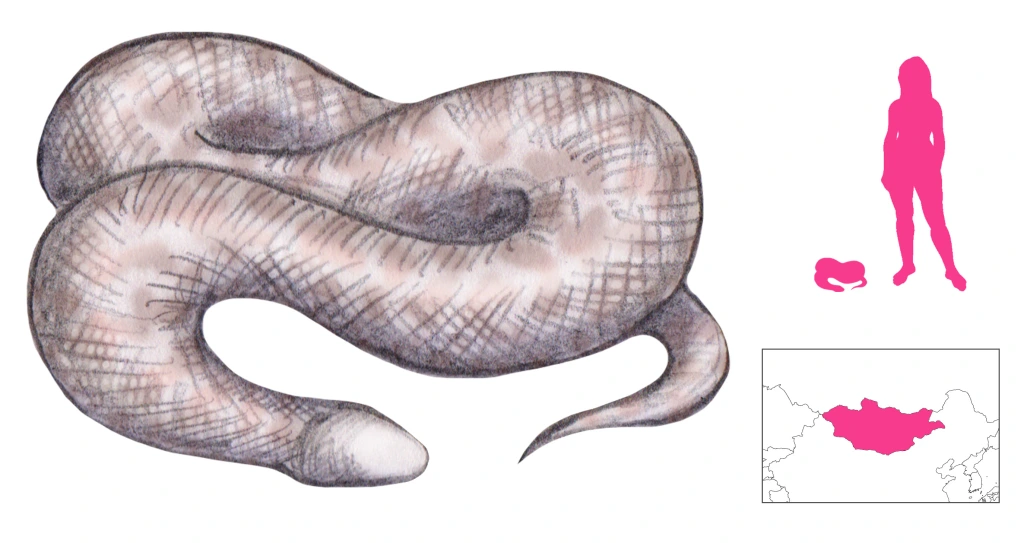Variations: Olgoi khorkhoi, Olgoj chorchoj, Allergorhai-horhai, Allergorhai horhai, Allghoi khorkhoi, Temen-Sul-Khorkhoi, Temeen Suul (Mongolian name of Tartar sand boa), Intestine Worm, Mongolian Death Worm, Tartar Sand Boa, Eryx tataricus

It has forever been in human nature to exaggerate the lethality of animals, regardless of whether or not the animal is actually deadly or even poisonous. Salamanders become fiery creatures whose breath slays, water shrews are accused of poisoning and killing cattle, geckos are so virulent they cause leprosy, viper venom causes the human body to melt… the list is endless.
One of the victims of this demonization is the creature known in Mongolia as the Olgoi-khorkhoi or “intestine worm”, also known in English by the even more sensationalistic name of “Mongolian death worm”.
Mongolian folklore is ambivalent on snakes. They are associated with dragons and the water world, and thus are worthy of respect and should not be killed; on the other hand, they are symbols of malice, antagonists to the forces of good, and hostile beings that should be destroyed. Saying the word mogoi (“snake”) is not recommended, with euphemisms like urt khorkhoi (“long worm”) or khairkhan (“holy” or “merciful”) used instead.
The olgoi-khorkhoi is a serpent that looks like a sausage, two feet (0.6 meters) long, and lacks a head and legs. Its color is a white brocade. It is so poisonous that looking at it is dangerous and anyone who touches it dies instantly. It lives in the sandiest, driest areas of the Western Gobi desert. If it shows up in a yurt, the inhabitants move out. It comes out after the rains when the ground has become damp.
Paleontologist Roy Chapman Andrews was informed of the olgoi-khorkhoi’s existence by the Mongolian Premier, and went on to hear much about it. Usually people had not seen one themselves, but knew others who had, and every time they went to a play where the olgoi-khorkhoi was said to be abundant, the inhabitants told them the creature could be found a few miles away. The scientist was optimistic about his chances of capturing one thanks to the neutralizing powers of dark glasses and steel forceps. No specimen was ever seen or captured, however.
The existence of the olgoi-khorkhoi was popularized by Andrews and fellow paleontologist and science-fiction author I. A. Efremov, and much has been posited since about its appearance, habits, and true nature.
However, the real identity of the olgoi-khorkhoi is far more prosaic: it is the Tartar sand boa, a desert-dwelling, nonvenomous snake. This was confirmed by Gorelov, who showed a specimen of the boa to people in the Gobi. They asserted that it was indeed an olgoi-khorkhoi and that they were afraid of it. Gorelov also reported an individual olgoi-khorkhoi preserved in a jar and exhibited in Dalaanzadgad Town during a holiday.
References
Andrews, R. C. (1926) On the Trail of Ancient Man. G. P. Putnam’s Sons, New York.
Andrews, R. C. (1932) The New Conquest of Central Asia. The American Museum of Natural History, New York.
Kuzmin, S. L.; Dunayev, E. A.; Munkhbayar, K.; Munkhbataar, M.; Oyuunchimeg, J.; and Terbish, K. (2017) The Amphibians of Mongolia. KMK Scientific Press, Moscow.
Shuker, K. P. N. (2003) The Beasts that Hide From Man. Paraview Press, London.
Eryx tataricus is presently considered a junior synonym of E. miliaris (Eskandarzadeh et al., 2020).
LikeLiked by 1 person
Ah crap I’m behind on my herpetology 😦
LikeLike
What is your source of reference for the information attributed to Gorelov?
LikeLiked by 1 person
Found it! As I suspected, it’s in Kuzmin, S. L.; Dunayev, E. A.; Munkhbayar, K.; Munkhbataar, M.; Oyuunchimeg, J.; and Terbish, K. (2017) The Amphibians of Mongolia. KMK Scientific Press, Moscow, a copy of which I’ve now managed to procure in English. Interesting, yet it seems a little hard to believe that such an extensive mythology, featuring a blood-red, 5-ft-long beast that spits out acidic venom and electrocutes entire herds of camel if they walk over sand that it is hiding beneath, should have been inspired by such an innocuous, insipid beast as a sand boa. Also, it does not explain the case of the Western scientist visiting Mongolia’s Gobi many decades ago who was killed instantly by one of these death worms when he touched it with an iron pole, an event that suggests electrocution.
LikeLiked by 2 people
This is why you’re supposed to call Miss Utility before you dig for monster snakes.
LikeLiked by 2 people
Can you do one about Aigamuxa in future?
LikeLiked by 1 person
I don’t know, on one hand it’s a human-type and I’m trying to avoid those for my own sanity (also I don’t know how to draw). But then there’s stuff I’d like to say about them…
LikeLike
He looks very reminiscent of something.
LikeLiked by 2 people
Nice work! Apparently Tartar sand boas are quite docile, so it’s surprising how they got turned into deadly beasts, yet it can still be seen a bit in how the worm doesn’t actively kill without cause but just meanders about to wherever it pleases without a care in the world.
LikeLiked by 2 people
Thank the gods there’s finally info online about this creature with not only an etymological history but also a less-sensationalized version of the folklore. The intestine worm has sadly been compromised by people’s memories of the Tremors movies and the Sandworm of various RPGs.
LikeLiked by 2 people
Excellent stuff!
LikeLiked by 2 people